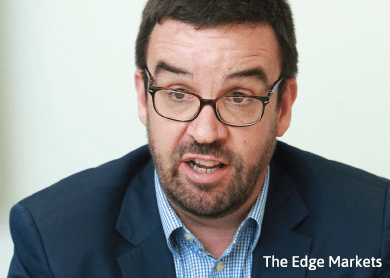
KUALA LUMPUR: PricewaterhouseCoopers (PwC) forecast that a number of large, globally relevant mergers and acquisitions (M&A) involving oil and gas (O&G) players will occur in the next 12 to 18 months as the sector consolidates to seek greater efficiency amid the protracted slump in global oil prices.
The industry, as it is, has “historically been driven by joint ventures (JV)”, according to PwC Australia partner and O&G specialist Brian Cooke (pic) in an interview with The Edge Financial Daily last week.
“There aren’t many O&G fields that aren’t structured under a JV type of arrangement. It’s a great opportunity for Malaysia because certain organisations globally may have technological advantages.
“In the enhanced oil recovery space, partnerships not only bring in money and minimalise financial risk, you also get a breath in capabilities and capacity that you may find hard to grow organically,” he said.
On that note, he said PwC expects to see a significant increase in M&A in the O&G sector this year and the next, “driven by the fact that scale brings efficiency”.
“We expect a number of large, globally relevant deals to occur over [the next] 12 to 18 months,” he said.
As for the oil price, the consultancy firm expects it to hover between US$60 (RM218) and US$65 per barrel for the rest of 2015 — with US$60 per barrel being the new benchmark for the midterm — and will gradually rise up to US$80 over the next two to three years.
Oil, like any commodity, said Cooke, is bound to go through a commodity cycle and will eventually bounce back.
“Oil prices have declined by more than six times in the last 40 years. On average, this happens every eight years. But the industry has been particularly hit hard this time around and oil prices globally have fallen more than 50%.
“Some forecasters have indicated that it could fall to US$40 or even US$30. I don’t believe that’s a possibility and what we are seeing now is a little bit of an uptake, back up to US$60. We think it’ll hover around US$60 or US$65 for the rest of 2015 and then gradually see it rising up to US$80 over the next two to three years,” said Cooke.
As at last Thursday, Brent was trading at US$65 per barrel.
On whether the O&G sector’s outlook is now dim, Cooke said it would be if one’s production cost per barrel is US$85 per barrel.
“The global average is US$38 per barrel. So, if your cost of production isn’t significantly lower than that price point, you’re going to be in trouble. The focus will be moving down the cost curve to improve your competitive position,” said Cooke.
He also noted that not everything is bad news with the global oil price decline, as it has been an economic stimulant to countries that are net energy importers.
“Malaysia is in that position. One of the major inputs on economy is the fact that oil is now cheaper and it’s a good economic stimulant for a broader economic growth within Asia,” he said.
He also noted that although O&G expenditures have seen a reduction, oil majors and national oil companies (NOCs) don’t generally cut back on production.
“It’s a depleting asset. If I’m producing 100 barrels of oil per day (bopd), I’m probably depleting my reserves by about 10% per annum. I’ll probably produce 90 bopd the next year and it comes down [again] the following year.
PwC Malaysia partner and O&G leader Nurul A’in Abdul Latif, who was also present at the interview, said at the current oil price level, many local industry players have taken a more cautious outlook in the medium term.
Cooke noted that this was also the case for O&G majors and NOCs across the globe — most have significantly cut down on upstream exploration and development activities, with some reducing their capital expenditure by up to 50% compared with previous years.
“The cut back on expenditure is a cut back on drilling new wells and exploring for new O&G. Without that expenditure, no new reserves will come on stream. Without new reserves, no new production will come on stream,” said Cooke.
He said that the cycle of exploration development and production is both a general lead and lag indicator. A lead indicator signals future events, while lag indicators are ones that come or follow a particular event.
“[But] generally, most organisations, once they’ve got a major well into production, will keep it in production because it’s very difficult to shut down,” he added.
This article first appeared in The Edge Financial Daily, on May 5, 2015.